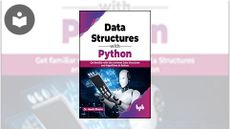Complex Data Types in Python: Working with Lists & Tuples in Python
Python
| Beginner
- 14 videos | 1h 39m 1s
- Includes Assessment
- Earns a Badge
Learn how to work with lists, tuples, and strings in Jupyter notebook in Python in this 14-video course. You will discover similarities and differences between tuples and lists and see how strings are essentially just a list of characters. Begin with an introduction to lists, and then create and initialize lists in Python. You will then access and update list elements; add, remove, sort, and reverse elements from a list; execute built-in functions with lists, and create new lists from existing lists by using slicing operations. Next, examine how to extract specific elements from the original list using step size; perform list functions on strings; invoke functions on the string object; and access substrings with slicing operations. Receive an introduction to tuples, exploring the similarities between lists and tuples, then move on to understanding tuple immutability by specifying differences between lists and tuples. Then an introduction to other complex data types and using dictionaries and sets in Python. The concluding exercise concerns recalling differences and similarities between lists and tuples.
WHAT YOU WILL LEARN
-
Discover the key concepts covered in this courseCreate and initialize lists in pythonAccess and update list elementsAdd, remove, sort, and reverse elements from a listExecuting built-in functions with listsCreate new lists from existing lists using slicing operationsExtract specific elements from the original list using step size
-
Perform list functions on stringsInvoke functions on the string objectAccess substrings using slicing operationsSpecify the similarities between lists and tuplesSpecify the differences between lists and tuplesUse dictionaries and sets in pythonRecall the ways in which lists and tuples are similar and different
IN THIS COURSE
-
2m 19s
-
8m 18sDuring this video, you will learn how to create and initialize lists in Python. FREE ACCESS
-
3. Performing Simple List Operations6m 26sIn this video, you will learn how to access and update list elements. FREE ACCESS
-
4. Performing Useful List Operations9m 2sIn this video, you will learn how to add, remove, sort, and reverse elements in a list. FREE ACCESS
-
5. Using Built-in Functions with Lists6m 9sIn this video, you will learn how to execute built-in functions with lists. FREE ACCESS
-
6. Perform Slicing Operations on Lists6m 53sIn this video, you will create new lists from existing lists using slicing operations. FREE ACCESS
-
7. Using Step Size in Slicing Operations7m 10sIn this video, find out how to extract specific elements from the original list using a step size. FREE ACCESS
-
8. Working with Strings as a List of Characters7m 49sIn this video, learn how to perform list functions on strings. FREE ACCESS
-
9. Invoking Functions on Strings7m 15sIn this video, you will learn how to invoke functions on the string object. FREE ACCESS
-
10. Perform Slicing Operations on Strings8m 15sTo find out how to access substrings using slicing operations, consult a Python reference guide or search online. FREE ACCESS
-
11. Introducing Tuples9m 15sAfter completing this video, you will be able to specify the similarities between lists and tuples. FREE ACCESS
-
12. Understanding Tuple Immutability8m 39sAfter completing this video, you will be able to specify the differences between lists and tuples. FREE ACCESS
-
13. Introducing Other Complex Data Types6m 22sDuring this video, you will learn how to use dictionaries and sets in Python. FREE ACCESS
-
14. Exercise: Lists, Tuples, Similar Yet Different5m 10sUpon completion of this video, you will be able to recall the ways in which lists and tuples are similar and different. FREE ACCESS
EARN A DIGITAL BADGE WHEN YOU COMPLETE THIS COURSE
Skillsoft is providing you the opportunity to earn a digital badge upon successful completion on some of our courses, which can be shared on any social network or business platform.
Digital badges are yours to keep, forever.






